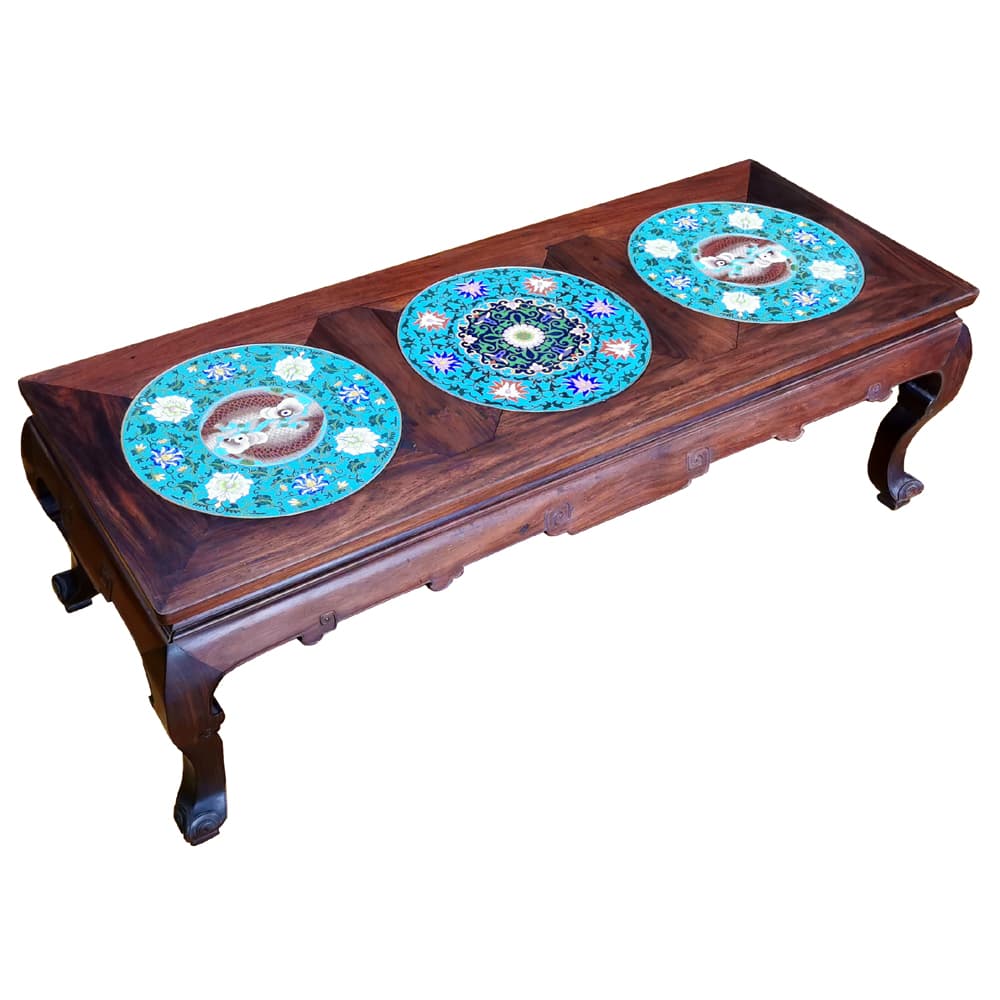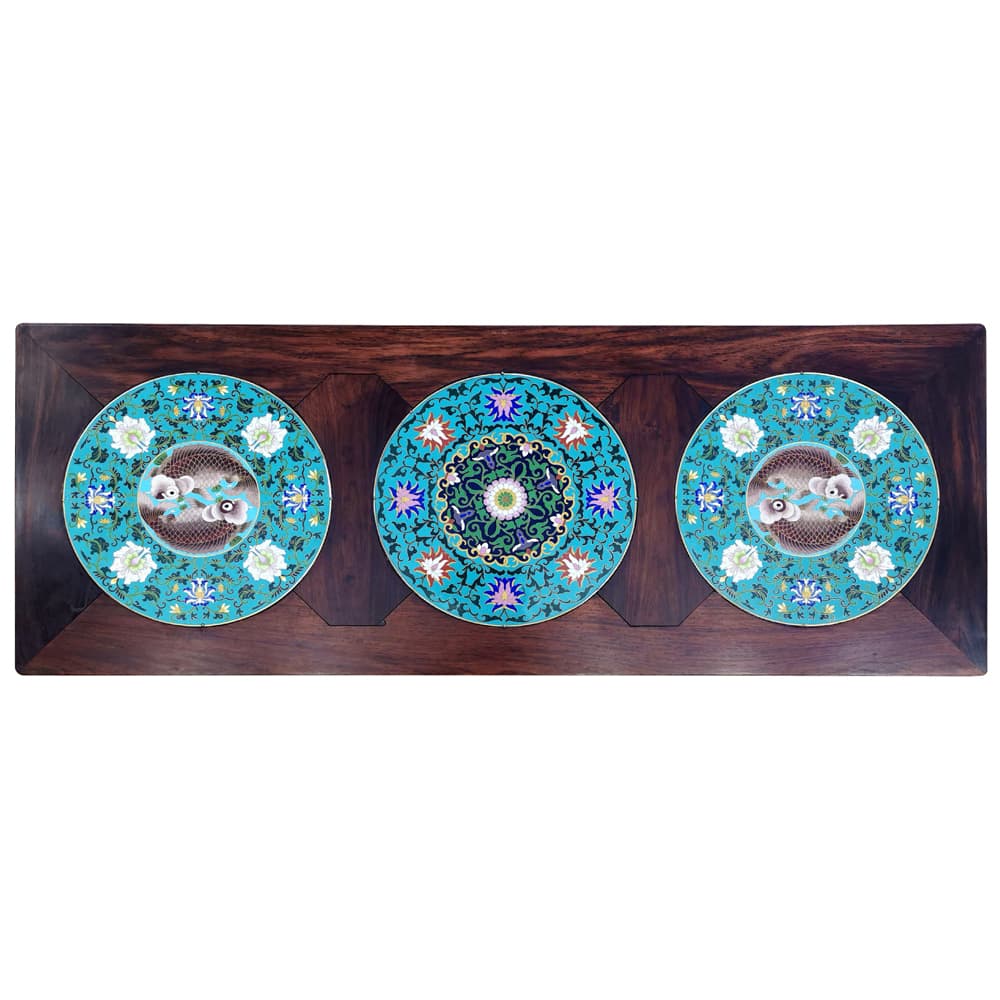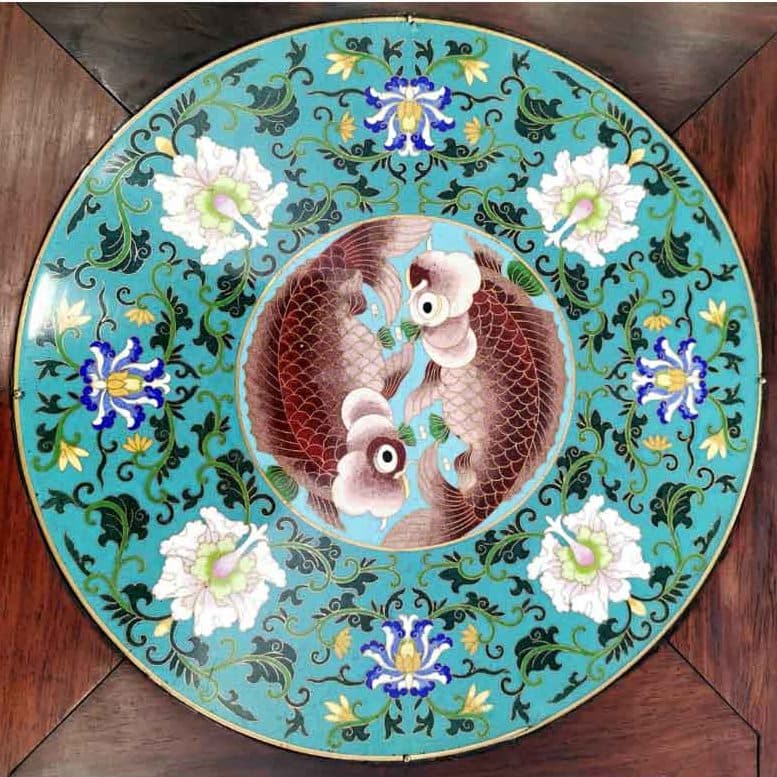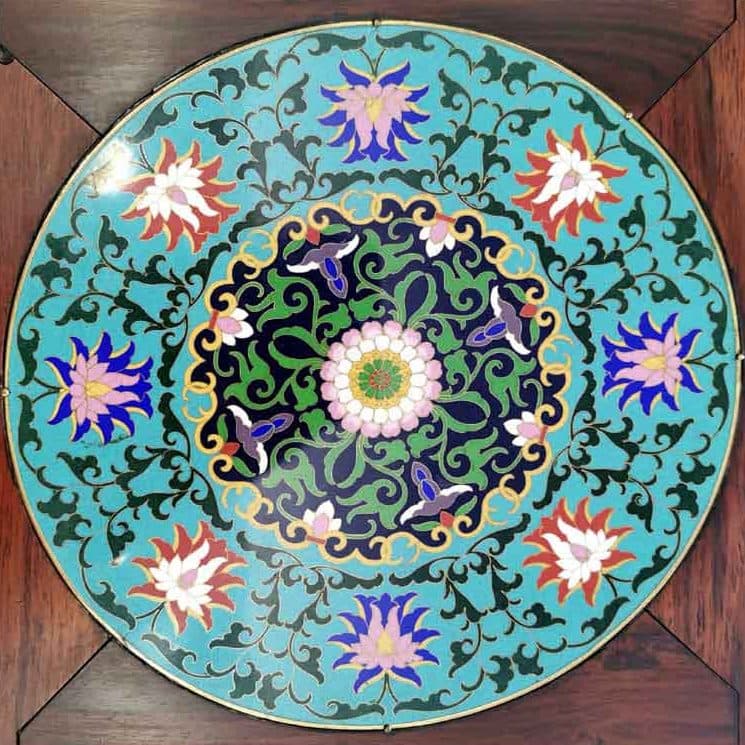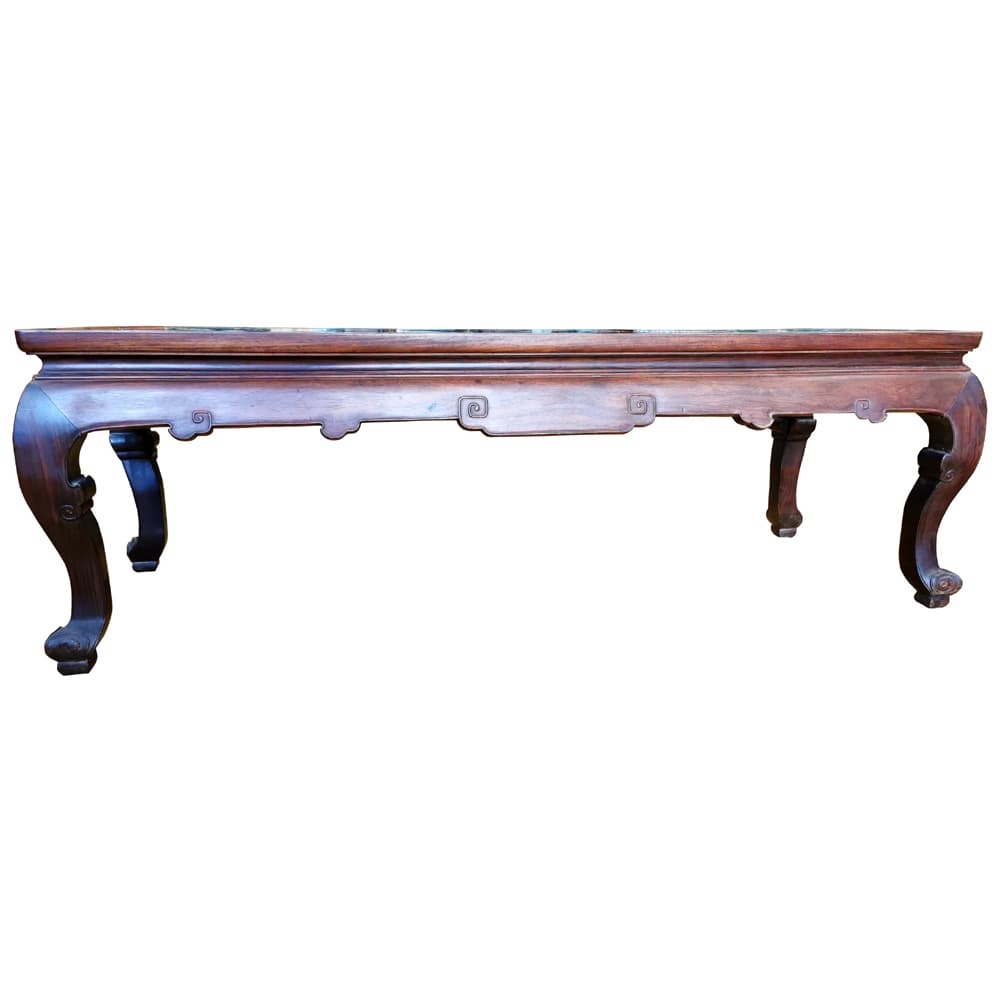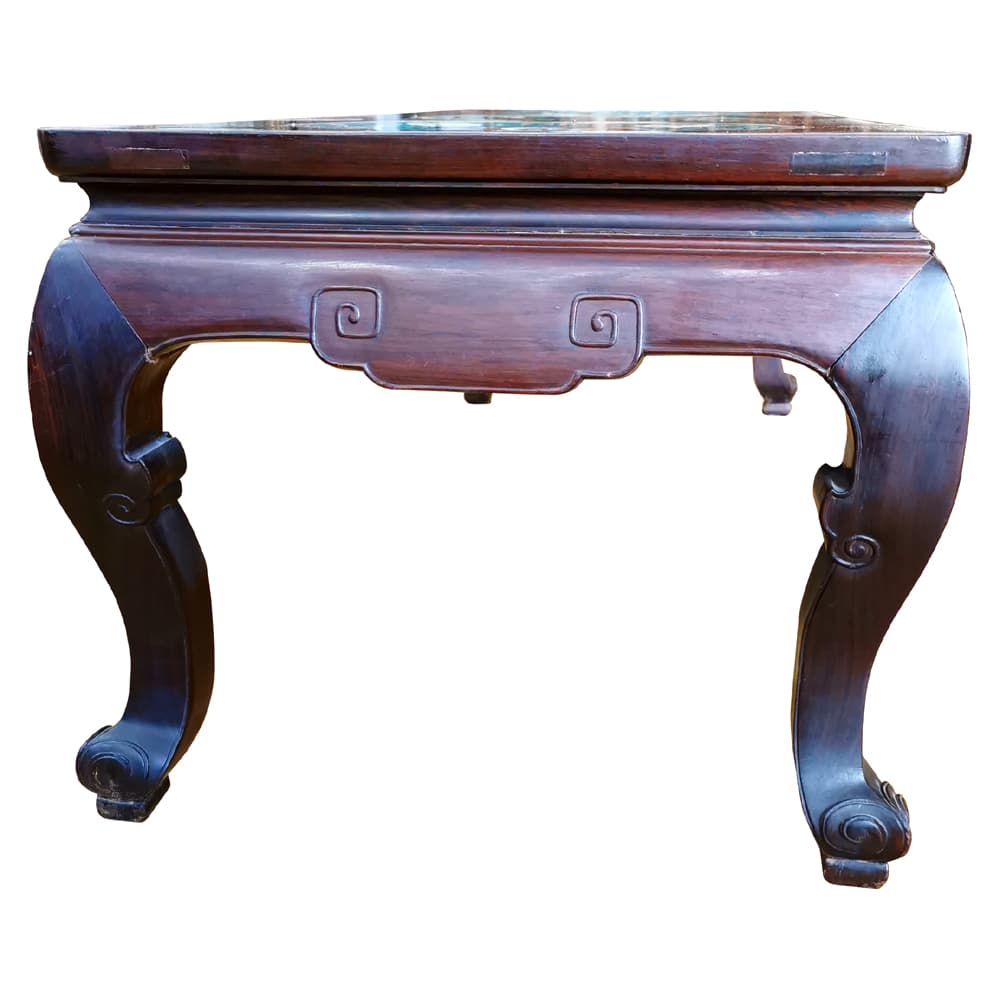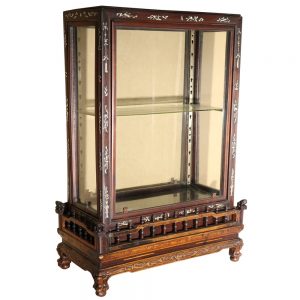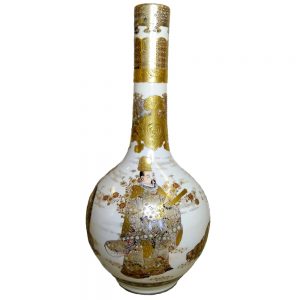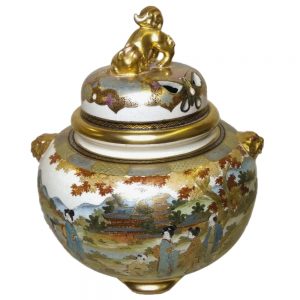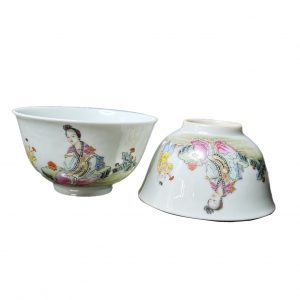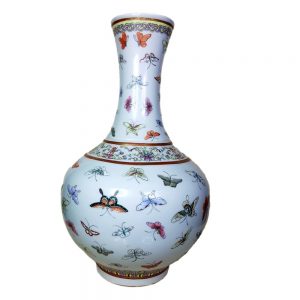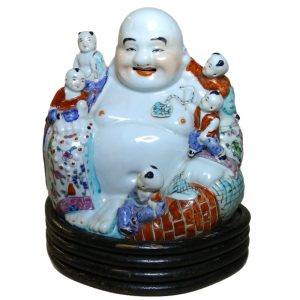Description
Chinese wooden table with cloisonne plates, antique of 20th century.
Dimensions: H 41.00 X W 48.50 X L 125.00 cm.
History of Cloisonne:
Cloisonné is an ancient technique for decorating metalwork objects with colored material held in place or separated by metal strips or wire, normally of gold.
In recent centuries, vitreous enamel has been used, but inlays of cut gemstones, glass and other materials were also used during older periods; indeed cloisonné enamel very probably began as an easier imitation of cloisonné work using gems. The resulting objects can also be called cloisonné.
The decoration is formed by first adding compartments (cloisons in French) to the metal object by soldering or affixing silver or gold as wires or thin strips placed on their edges. These remain visible in the finished piece, separating the different compartments of the enamel or inlays, which are often of several colors.
Cloisonné enamel objects are worked on with enamel powder made into a paste, which then needs to be fired in a kiln. If gemstones or colored glass are used, the pieces need to be cut or ground into the shape of each cloison.
History of Chinese Cloisonne:
From Byzantium or the Islamic world the technique reached China in the 13–14th centuries; the first written reference is in a book of 1388, where it is called “Dashi ware”. No Chinese pieces clearly from the 14th century are known, the earliest datable pieces being from the reign of the Xuande Emperor (1425–35), which however show a full use of Chinese styles suggesting considerable experience in the technique. It was initially regarded with suspicion by Chinese connoisseurs, firstly as being foreign, and secondly as appealing to feminine taste. However, by the beginning of the 18th century the Kangxi Emperor had a cloisonné workshop among the many Imperial factories. The most elaborate and highly valued Chinese pieces are from the early Ming Dynasty, especially the reigns of the Xuande Emperor and Jingtai Emperor (1450–57), although 19th century or modern pieces are far more common.
The Chinese industry seems to have benefited from a number of skilled Byzantine refugees fleeing the Fall of Constantinople in 1453, although based on the name alone, it is far more likely China obtained knowledge of the technique from the middle east. In much Chinese cloisonné blue is usually the predominant colour, and the Chinese name for the technique, jingtailan (“Jingtai blue ware”), refers to this, and the Jingtai Emperor. Quality began to decline in the 19th century. Initially heavy bronze or brass bodies were used, and the wires soldered, but later much lighter copper vessels were used, and the wire glued on before firing. The enamels compositions and the pigments change with time.
Chinese cloisonné is sometimes confused with Canton enamel, a type of painted enamel on copper that is more closely related to overglaze enamels on Chinese porcelain, or enamelled glass. This is painted on freehand and so does not use partitions to hold the colours separate.
In Byzantine pieces, and even more in Chinese work, the wire by no means always encloses a separate color of enamel. Sometime a wire is used just for decorative effect, stopping in the middle of a field of enamel, and sometimes the boundary between two enamel colors is not marked by a wire.
Chinese wooden table with cloisonne plates, antique of 20th century – A collectible and very beautiful table.
Code: E250
Shipping abroad
- For shipping cost outside of Greece, please contact us:
Mobile Phone: + (30) 6982005898 (Viber, What’s Up, WeChat.)
Store Phone: + (30) 2103634777
E-mail: info@lotusgallery.art and www.lotusgallery.art@gmail.com
Visit our store: 29 Solonos, Athens, 10671, Greece
Contact us by filling out the contact form: Contact
Purchase terms
All works of art are available for viewing in our store, by appointment.
Payment / Shipping / Delivery
Payment:
Methods of payment:
1) Payment with bank transfer.
2) Payment in our store.
3) Payment by phone (by bank card).
4) Cash on delivery (available only within Greece).
5) Payment by credit or debit card.
6) Payment through PayPal.
1) Payment with bank transfer:
Within one working day after the completion of your order, you will receive an e-mail from us with the invoice of your purchase. According to the invoice, payment will have to be made in full within 10 working days. For an immediate payment of your order with no other procedures, you can make your payment through web or online banking. You will insert your order code and the amount, as mentioned in your invoice. The payment of your order can also be made at a branch of your bank. We will automatically receive your payment and your order will be processed immediately.
2) Payment in our store:
Within one working day after the completion of your order, you will receive an e-mail from us with the invoice of your purchase. According to the invoice, payment will have to be made in full within 10 working days. Payment in our store is made through POS (credit or debit card) or cash.
3) Payment by phone:
Within one working day after the completion of your order, you will receive an e-mail from us with the invoice of your purchase. According to the invoice, payment will have to be made in full within 10 working days. For payment by phone, please contact us: +(30) 2103634777 / +(30) 6982005898.
4) Cash on delivery (available only within Greece):
For those who prefer the more traditional method, the goods are delivered by the drivers of Lotus Gallery Art or the Greek Post Office (ELTA) or a courier and you pay cash on delivery.
5) Payment by credit or debit card:
If you have a credit / debit VISA or MasterCard, you can use it securely though our form. The process of payment through credit cards is covered by modern security standards.
6) Payment through PayPal:
You can use it securely. The process of payment through PayPal is covered by modern PayPal security standards.
Bank charges in case of purchase are borne by the buyer !!!
Shipment / Delivery
The shipping of goods is made within three working days after the payment.
For our shipments we use the Greek Post Office (ELTA).
Shipment can also be made with a way of transfer of your choice, but at your own expense.
After the shipment, we will send an e-mail with the details of the shipment and a barcode, so that you can track your parcel.
You can also collect your orders from our store with no shipping cost.
We inform you that objects of art cannot be returned, unless you have received a wrong order, or an object is damaged during shipment.
Shipping cost includes:
1) Way of transfer: (Lotus Gallery Art driver or ΕLΤΑ or courier).
2) Size of object: (Big items need special shipment).
3) Way of packaging: (Fragile and big items need a wooden box).
4) Insurance: (High value items need an insurance).
If you need further information about an item you are interested in, please contact us or visit our store!


